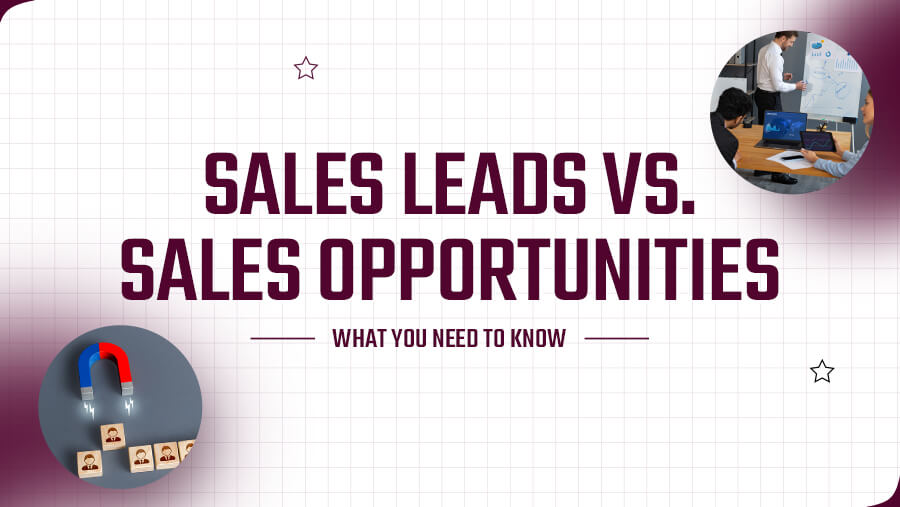
What Are the Top Key Differences Between Sales Leads and Opportunities?
Only 1 in 25 of sales leads turn into paying customers. This can be frustrating, but it doesn't have to be.
Begin by understanding the critical differences between a sales lead and an opportunity. Then, you can improve your sales process and turn more prospects into paying customers.
- A sales lead is a potential consumer interested in your product or service.
- On the contrary, an opportunity is a qualified lead that has the potential to become a paying customer.
In this blog, we'll explore the key differences between them.
Additionally, we’ll provide tips on how to upgrade your sales process to increase your success rate. So, whether you're new to sales or a seasoned pro, we have something for everyone. Let's get started!
What Is a Sales Lead?
All sales start with a lead. So, let's take a closer look at what exactly it is.
A potential customer has shown interest in your product or service. They are placed at the top of your sales funnel.

But what makes a lead a sales lead? Sales leads typically have specific characteristics that set them apart from other leads.
For example, they may have requested more information about your product or subscribed to your email list. They may also have engaged with your brand on social media or attended a webinar you hosted.
Sales leads can be generated in a variety of ways. Some of the channels are –
- Your website
- Social media pages
- Outbound marketing campaigns
- Trade shows
The important thing is to identify where your leads are coming from. Only then can you continue to invest in those channels.
Sales leads are the lifeblood of your sales process, providing you with a pool of potential customers to target. With them, you would have someone to sell to.
That's why it's crucial to have a solid strategy for generating, nurturing, and converting leads into paying customers.
What Is a Sales Opportunity?
Now that we understand sales leads well, let's move on to opportunities. As we already mentioned, an opportunity is a prospect identified as a potential customer who meets certain qualifying criteria, indicating a higher likelihood of conversion into a paying customer.
But what sets an opportunity apart from a sales lead?
Opportunities are typically characterized by their level of engagement and readiness to buy.
For example, they may have asked for a quote or expressed a strong desire to purchase your product.
But how are they created? Opportunities are derived when sales leads are nurtured and qualified through the sales process. This involves the following steps:
- Identifying the best leads
- Building rapport with them
- Answering any questions they may have
By doing so, you can determine whether they are a good fit for your product and are ready to purchase it.
In short, opportunities are the end goal of your sales process. They are the leads that are most likely to turn into paying customers, and they represent the potential for new business and revenue. That's why focusing on converting leads into opportunities and closing more deals is important.
What Are the 4 Key Differences Between Lead Stage and Opportunity Stage

By now, you already have the answers to these two key questions. Is opportunity management the same as lead management? NO. What comes first, lead or opportunity? Of course, it is the lead!
Let's next delve into the key differences between the two. Understanding these distinctions will help you better gauge where your leads are in the sales process and how to move them closer to becoming paying customers.
1. Qualification
One key difference between a sales lead and an opportunity is qualification.
- A sales lead is an unscreened contact who may be interested in your product or service but may not be a good fit for your business.
- Conversely, an opportunity has been qualified and is considered a good fit for your business.
2. Progress in the Sales Process
Yet another prime distinction between a sales lead and an opportunity is their progress in the sales process.
- Sales leads are just the beginning. They can evolve into contacts, accounts, or opportunities.
- Opportunities, on the other hand, are further along in the process. In short, they are considered more likely to close.
3. Communication and Engagement
The level of communication and engagement between you and your leads is another factor that distinguishes sales leads from opportunities.
- Sales leads may have yet to engage with your brand.
- Meanwhile, opportunities are typically more involved. Additionally, they have had more conversations with your sales team.
4. Sales Stage
Sales cycle stages usually comprise multiple steps, from defining objectives to closing deals. Hence, you must consider the stage in the sales process as well.
- Sales leads are typically in the early stages of the process.
- However, sales opportunities are further along and closer to becoming a paying customer.
NOTE:
- A sales lead is an unscreened contact. On the other hand, a sales opportunity signifies a potential sale.
- A lead can be transformed into a contact, an account, or an opportunity.
- To determine if a lead has the potential to become an opportunity, consider their level of interest in your product, authority, budget, and timeline.
How to Upgrade from a Sales Lead to a Sales Opportunity?
So far, we've explored the definitions and differences between sales leads and opportunities. But now, your next question may be: When does a lead become an opportunity?
The answer?
You can upgrade prospects to the next stage only when you take essential steps. Again, you may wonder – is it mandatory to convert lead into opportunity? The answer is yes!
So, let's discuss how you can upgrade from sales leads to opportunities.
1. Qualifying Sales Leads
To qualify a lead, you must determine if they fit your ICP (ideal customer profile). For B2B companies, you can use various frameworks such as BANT (Budget, Authority, Need, Timeline) or demographic criteria—age, location, job title, company size, and industry.
You may also use behavioral criteria, such as website visits. Another method is calculating the Fit Score. It combines the above criteria and ranks leads by how closely they match your ICP. This helps identify high-quality leads and prioritize them for follow-up.
Now, why is lead qualification critical?
Qualifying your leads can help you prioritize your time and resources. Additionally, it can help you ensure you are focusing on the leads that are most inclined to close.
2. Building Strong Relationships with Prospects
Fostering solid and lasting relationships with your prospects is key to your success. This involves regularly communicating with your leads, answering their questions, and addressing their concerns.
By building a strong connection, you can establish trust with your prospects, which in turn increases their likelihood of becoming paying customers.
3. Personalizing Communication and Engagement
It is of utmost importance to customize the ways you engage with your leads. This means tailoring your communication to each lead's specific needs and preferences.
Personalizing your dialogue can make your leads feel heard and valued. Hence, it can increase engagement and a higher probability of closing the deal.
4. Providing Apt and Beneficial Information
Finally, providing relevant and valuable information to your leads is essential. This involves educating your leads about your product or service and conveying how your offerings can solve their specific issues.
By providing appropriate insights, you can establish yourself as a trusted expert, which multiplies your chances of upgrading your leads to opportunities.
Wrapping It Up
Understanding how to upgrade from leads to opportunities is crucial for any business aiming to improve its sales process and close more deals. And if you're looking for a platform to help you manage and track your sales leads and opportunities, consider Revnew.
It is an all-in-one solution that can help you qualify leads, build relationships, personalize communication, and provide valuable information all in one place. With Revnew, you can streamline your sales process, increase efficiency, and close more deals. So, if you're ready to upgrade your sales process and convert more leads to opportunities, contact us today!




